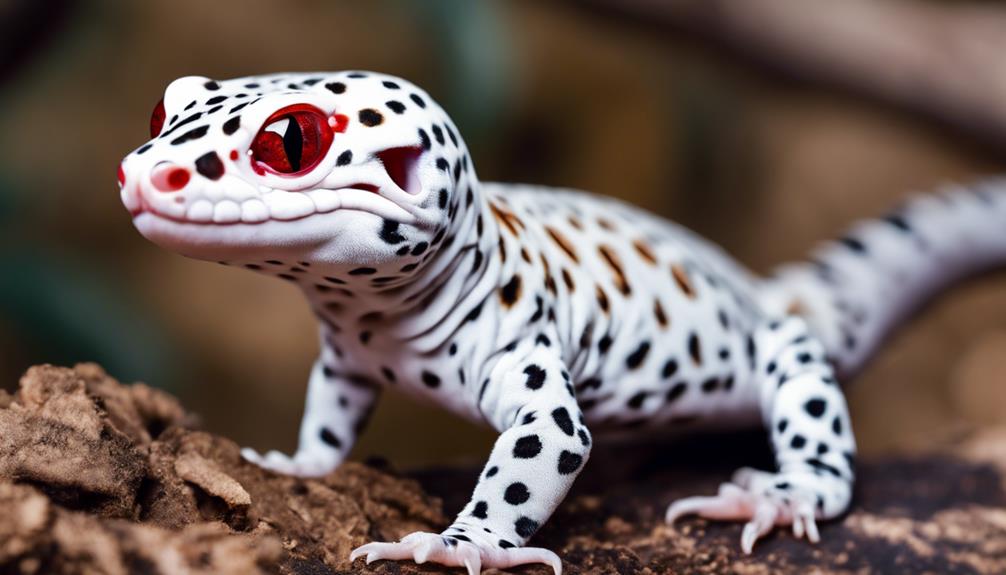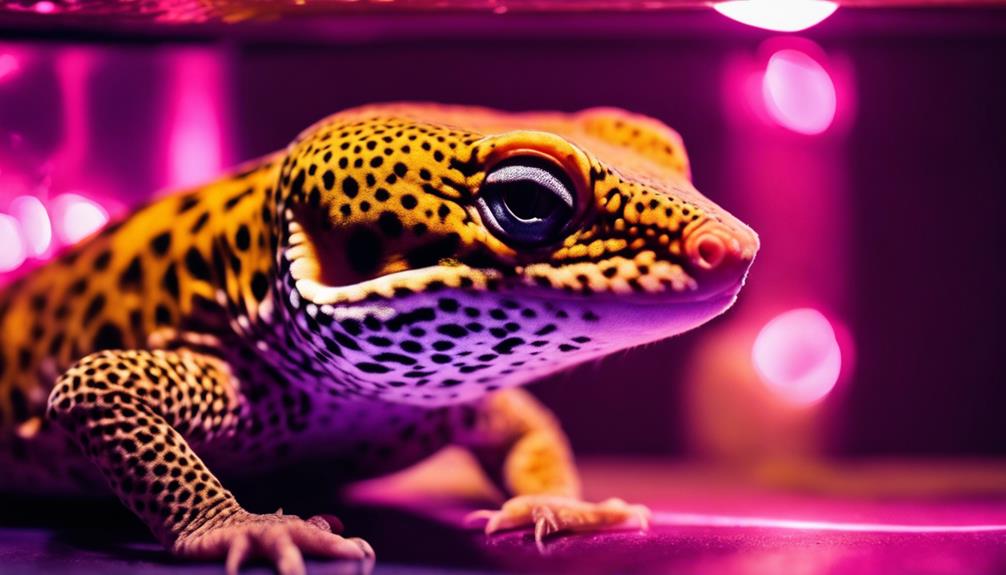If you’ve ever wondered about the mesmerizing allure of leucistic leopard geckos, prepare to be intrigued by their stunning features.
These unique reptiles possess a beauty that goes beyond their striking appearance.
Exploring the intricacies of their genetics and the fascinating facts surrounding their care and breeding will provide you with a deeper understanding of what makes these geckos truly stand out in the world of reptile enthusiasts.
Discover the secrets that lie beneath the surface of these enchanting creatures and reveal a world of wonder waiting to be discovered.
Key Takeaways
- Leucistic geckos boast a mesmerizing white coloration from a genetic mutation.
- Their pink or yellow eyes and unique white shades set them apart.
- Behavior includes nocturnal habits, burrowing instincts, and tail autotomy for defense.
- Breeding for the recessive leucistic trait yields stunning, sought-after white geckos.
Physical Characteristics and White Coloration
In leucistic leopard geckos, the absence of dark pigmentation results in a stunning white coloration, distinguishing them from other gecko variations. This striking white appearance is a product of a genetic mutation that disrupts the production of melanin, the pigment responsible for skin coloration. As a result, leucistic geckos exhibit a pure and vibrant white hue that captivates reptile enthusiasts worldwide.
Not only do these geckos lack dark pigmentation on their skin, but their eyes also showcase a unique feature. Due to the absence of melanin in the iris, leucistic geckos often have pink or yellow eyes, further enhancing their distinctive look.
Thus, the white coloration of leucistic leopard geckos can vary subtly, with some individuals displaying shades of white that add depth and character to their overall appearance. This variation in white shades contributes to the uniqueness of each leucistic gecko, making them coveted among reptile enthusiasts seeking a visually striking and aesthetically pleasing pet.
Behavior and Temperament Insights
Leucistic leopard geckos demonstrate a gentle disposition and calm temperament, making them favored among both novice keepers and seasoned reptile enthusiasts. Their docile nature sets them apart, allowing for easy handling and interaction. These geckos, which are only available as captive-bred specimens in the reptile trade, exhibit behaviors that are ideal for those looking for a low-maintenance reptile companion. Despite their small size, reaching 6 to 7 inches as adults within 18 months, leucistic leopard geckos can live up to 30 years in captivity with proper care, forming long-lasting bonds with their owners.
| Behavior Traits | Description |
|---|---|
| Nocturnal | Active at night, they spend the day resting in their shelters. |
| Purring Sound | When content, they may emit a soft purring sound while being handled. |
| Tail Autotomy | As a defense mechanism, they can drop their tails, which regenerate slowly. |
| Temperature Basking | Enjoy basking under heat lamps to regulate body temperature. |
| Burrowing Instinct | Have a natural tendency to burrow, requiring appropriate substrate in tanks. |
Unique Care Requirements and Habitat
With specific environmental needs, ensuring the proper care and habitat setup for leucistic leopard geckos is essential for their well-being and longevity. Leucistic leopard geckos require a warm and dry habitat with a temperature range of 88-92°F during the day and 70-75°F at night. Providing multiple hides and a substrate like paper towels or reptile carpet is important for their well-being. These geckos are sensitive to high humidity levels, so maintaining a humidity range of 20-40% is key. Unlike other leopard geckos, leucistic geckos don’t require UVB lighting due to their albino genetics. Regularly dusting their prey with calcium and vitamin supplements is crucial for their health.
- Maintain temperatures between 88-92°F during the day and 70-75°F at night.
- Provide multiple hides and suitable substrates like paper towels or reptile carpets.
- Keep humidity levels between 20-40% to prevent issues.
- Avoid UVB lighting as it’s unnecessary for leucistic leopard geckos.
- Ensure prey is dusted with calcium and vitamin supplements regularly for their well-being.
Breeding and Genetics of Leucistic Geckos
To understand the breeding and genetics of leucistic geckos, one must grasp the intricate genetic mechanisms that govern the expression of the striking white coloration in these unique reptiles. Leucistic leopard geckos are selectively bred to lack skin pigmentation, resulting in their stunning white or pale appearance. The leucistic trait is recessive, necessitating both parents to carry the gene for the offspring to exhibit the trait. Breeding for leucistic geckos involves pairing individuals with the leucistic gene to produce visually striking white geckos. These geckos lack melanin production, which contributes to their distinctive coloration, making them highly sought after in the reptile breeding community. Understanding the genetics of leucistic geckos is crucial for successful breeding programs focused on producing these alluring white leopard geckos.
| Breeding and Genetics of Leucistic Geckos |
|---|
| Leucistic trait is recessive |
| Selective breeding for white geckos |
| Lack of skin pigmentation |
| Importance of genetic understanding |
| Highly sought after in breeding community |
Fascinating Facts and Trivia About Leucistic Leopard Geckos
Exhibiting a striking white coloration with enthralling red or pink eyes, leucistic leopard geckos stand out for their unique appearance and lack of dark pigmentation. Here are some fascinating facts and trivia about these enthralling creatures:
- Leucistic leopard geckos are known for their stunning color, which is a result of their lack of melanin pigment.
- The red or pink eyes of leucistic geckos add to their ethereal and otherworldly look, distinguishing them from other gecko morphs.
- Unlike albino leopard geckos, leucistic geckos don’t exhibit the typical yellow-and-white coloration but rather appear completely white.
- The absence of dark pigmentation in leucistic geckos gives them translucent skin, further enhancing their unique appearance.
- Collectors and enthusiasts are drawn to leucistic leopard geckos due to their enthralling contrast against the more common colors found in typical leopard gecko morphs.
Frequently Asked Questions
What Are the Distinguishing Features of Leopard Geckos?
Leopard geckos display various color variations, adapting to their natural habitats. Their diet preferences vary, from insects to worms. These distinguishing features make them fascinating creatures to observe and care for in a captive setting.
How Big Do Leucistic Leopard Geckos Get?
Leucistic leopard geckos reach a maximum size of 6 to 7 inches within 18 months. They have a slower growth rate compared to other morphs. An ideal enclosure size for them is at least 10 gallons to guarantee adequate space.
What Are the Unique Characteristics of Geckos?
Geckos exhibit a wide array of color variations, from vibrant yellows to earthy browns. Their feeding habits include a diet of insects and occasionally fruits. Geckos prefer habitats with hiding spots, warm temperatures, and substrate for burrowing.
What Are the Adaptations of Leopard Geckos Feet?
When exploring diverse terrains, your leopard gecko’s feet showcase remarkable adaptations. Their specialized grip, unique locomotion, and toe pad characteristics allow for climbing vertical surfaces and sensing vibrations, aiding in hunting and survival in their environment.
Conclusion
Thus, leucistic leopard geckos are like rare gems in the world of reptiles, their white coloration shining brightly among the vast array of species. Their gentle nature and stunning features make them a prized addition to any reptile enthusiast’s collection.
With proper care and attention to their unique requirements, these mesmerizing creatures will continue to delight for years to come, like precious pearls in a sea of reptilian diversity.


